#book outline
Note
Hi! So, I’ve struggled A LOT with this in the past, and I was just wondering what a good way to outline a book was? I understand that there are many different ways to do it, and that it’s different for each person, but it’s hard to find good examples online on the different methods.
When we talk about outlining, we're often talking about structure, even though I think the best outlining also offers some connective tissue between the events of the story and the motivations and consequences of those events. My personal favorite outlining method is what I call a narrative outline, which is kind of like a reverse synopsis. In a narrative outline, you pretend you're explaining your story to someone very invested in it, who wants to know all about it. It's in paragraph form and written in your voice. It can be casual and incomplete. You can fill in the gaps with things like [FIGURE THIS OUT LATER]. Then you can take each paragraph you've written and make it into a chapter.
Sometimes, though, I don't even know enough about what I'm working on to do a narrative outline, and that's when I break out the tried and true four-part structure. This structure has served me well for many years, and even if it doesn't work for you, it's at least a place to start. Long-form stories generally have four major parts: exposition, rising action, climax, and denouement. I like to think of them as buckets in which I toss various scene ideas. The scene where characters A and B meet probably goes in exposition, which is the part concerned with establishing context and leading to an inciting incident. My characters getting to know one another would fall into the rising action bucket. Rising action involves raising stakes and escalating the tension. Then, the climax. This is when the rising action culminates into a major breaking point. Maybe my characters have a fight and break up. And lastly, my denouement, the action that falls in the aftermath of the climax. Here's where my characters, after some time apart, reunite.
Generally speaking, the halfway point of a story parallels the ending. If your halfway point is a major success of some kind, you likely will also have a happy ending. If your halfway point is a failure or a loss, you're probably writing a tragedy. Deciding off the bat, "Will this have a happy ending or a sad one?" will help you start putting events in order. Of course, there are also complicated or bittersweet endings, and those will also be reflected at the halfway point. For a complicated ending, your halfway point may be the most complex part of the book, the point with the least clarity. And a bittersweet ending will have a bittersweet middle.
Other writers have other structures they employ. There's Freytag's pyramid, which is two parts only: rising and falling action. There's the three-act play and the five-act play. There are the six stages and the eight key turning points. I've used all of these just to test them out, but I always end up back at my four parts. The trick to choosing an outlining method or an existing structure is to use it only as a jumping off point. It's a lot easier for me to start writing something knowing my job is just to fill four buckets. Often I end up with five parts instead of four. Don't box yourself in too much; as you begin writing, your story will let you know how it wants to be written. Trust your process and your intuition.

For those just joining us, @bettsfic is running a writing workshop on @books this month. Want to know more? Start here.
#tumblr writing workshop with betts#q&a with betts#writing advice#book outline#narrative strategy#writeblr
161 notes
·
View notes
Text
Book Outline
Over the course of the years, I've been working to make an official book outline that could cover everything a writer would need for their story, and now I'm introducing it to you here.
Thank you to @inky-duchess for some very extensive questions on world-building!
This is a collab with many authors I have worked with to create an outline with everything! I am always willing to update it as well, so if you have any suggestions let me know! Just copy and paste to use it for your own books! (:
25 notes
·
View notes
Text
Create 3-Dimensional Characters!
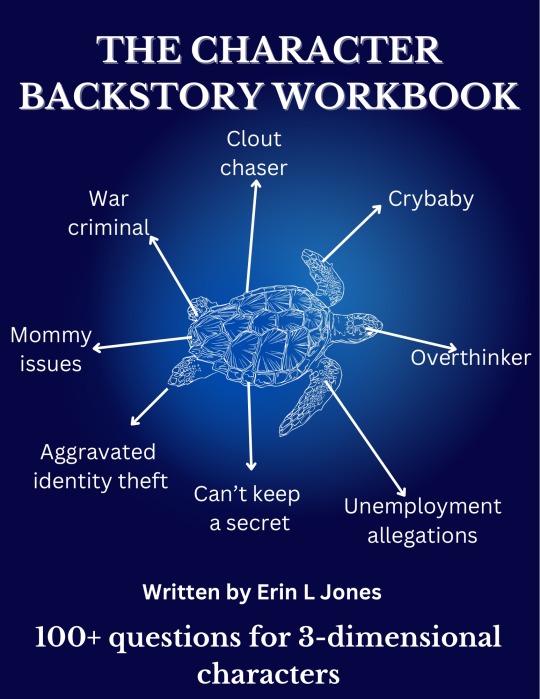


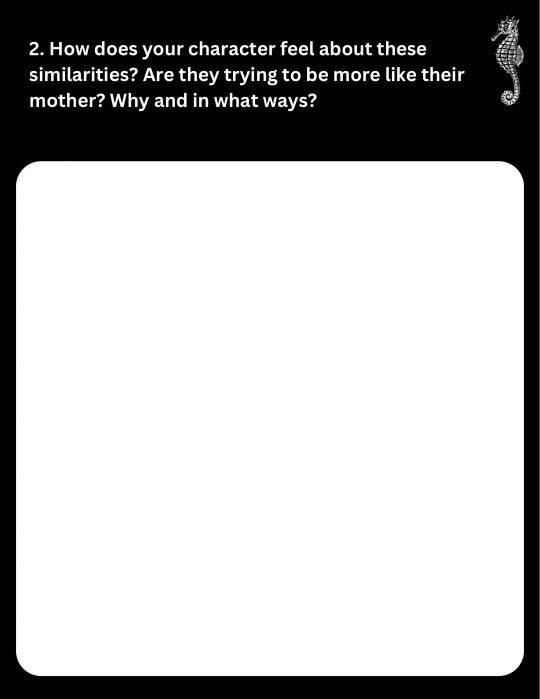
After years of using character profile templates and being frustrated by the fact that there is never enough room to write and that the questions didn’t go deep enough, I created The Character Backstory Workbook! As an author who knows that readers come for the plot, but stay for compelling characters, I set out to create a tool for writers who want to craft 3-dimensional characters that readers could have an emotional investment in and know like their best friend. Asking what a character’s hair color is isn’t “unhelpful,” but most writers need questions that trigger their imagination.
This 100+ question digital download (or you could print it out) includes:
• A family history deep-dive
• A closer look into your character’s childhood
• Explores their platonic and romantic relationships (past and present).
• Examines their goals, desires, fears, flaws, strengths, and how they transform the plot! + more
This book will spark ideas and build character arcs that raise the stakes in your plot! Grab a copy and get to writing ♥️
#writers on tumblr#writers of tumblr#creative writing#artists on tumblr#dark academia#cottagecore#novel writing#writblr#screenwriting#writing#screenplay#nanowrimo#book writing#book outline#romance writing#writing prompt#writing community#writing inspiration#writing advice#writing tips
6 notes
·
View notes
Text
Amp up your novel with 15 beats!
A writer’s mind is full of ideas, but the problem is with the writing process itself because we dread writing in words. Our plots sound amazing in our heads, but when put in words, readers don’t find them relatable. Readers even drop books midway if the stories are disorganized.
So, after hundreds of rejected manuscripts and tons of writing workshops, I came across fifteen beats which can amp up…

View On WordPress
0 notes
Text
We will encounter all these ideas and arguments later in this book, and I will carefully separate my opinion from that of science – or rather what we know with a level of certainty.
"Human Universe" - Professor Brian Cox and Andrew Cohen
#book quote#human universe#brian cox#andrew cohen#ideas#arguments#book outline#opinion#science#facts#nonfiction
0 notes
Text
To Outline or Not to Outline
To Outline or Not to Outline
To outline or not to outline, this is an important question for writers.
Should writers write books by following an outline? This seems to be a great debate among writers. Some writers swear by using outlines and others would rather fly by the seat of their pants.I prefer to make and use an outline when I am writing my books. I like to form a basic outline that lays out the gist of what the book…

View On WordPress
#Author Deanna Martinez-Bey#Authors#book outline#for writers#the writers circle#writers#writing books
0 notes
Text
If you hate writing outlines it's because of how they're taught in school. Toss out indentation and Roman numerals and map out your writing how you want to. Outlines are your FRIEND, dammit.
This goes for everything, from political essays to fanfiction. If it's written you need an outline because the outline is for you. It can be general, vague, or a mixture of both! Be as informal as you want, who cares. They're to keep you on track and keep your writing flowing, so don't disregard them even if you dreaded making them in grade school.
My outlines by chapter tend to look like this:
1. Character "P" goes to the diner to meet character "Q."
2. "P" tells "Q" about how the confrontation went. (dialogue I thought up on a bus ride) That's when shit goes DOWN. They're yelling, they're drawing attention to themselves, but before they can take it outside, "P" says (dialogue I thought up in the shower).
3. THEN "Q" SAYS THAT ONE LINE THAT "R" SAYS TO HIM IN CHAPTER FIVE BECAUSE THAT'S CALLED COHESION WOOOOO
4. idk they both leave??? you'll figure it out later
5. Self-reflection for "P." Keep your main point on how his moral compass goes to extremes and hurts others. He finally is realizing that HE is the PROBLEM
6. "P" drives to "Q's" house to apologize but GUESS WHO ANSWERS THE DOOR it's "R" and then just end the chapter there
This is coming from someone who didn't write with outlines for years. Now I don't write anything longer than 400 words without one! Make them your own, make them so that they're useful to you. That's their purpose, so accept the help!
#writers on tumblr#writing tumblr#writing help#writing advice#writing tips#writing blog#writer tips#writing motivation#outlining#book writing#novel writing#writeblr#writer#writing tip
2K notes
·
View notes
Text
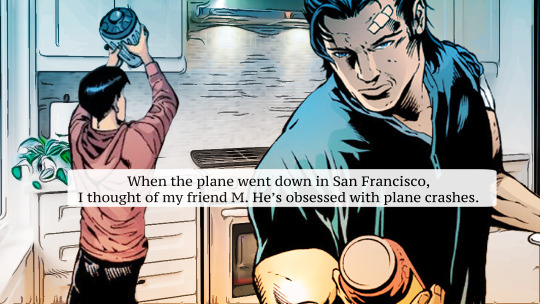
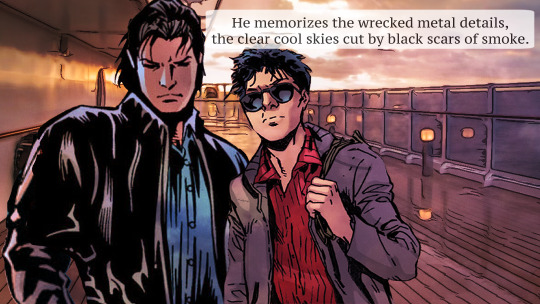


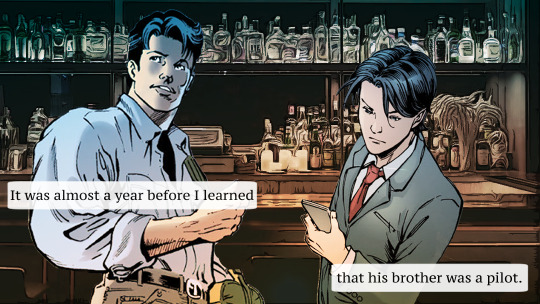
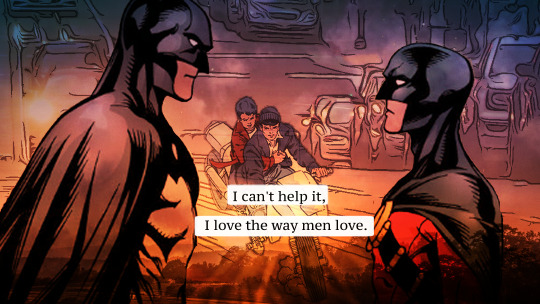
poem: "accident report in the tall, tall weeds" by ada limón
#when i started fussing with this it was going to be a pitch for that never-made comic series where tim moves to blüdhaven#when dick is injured and helps out as nightwing for a while#but then it felt weird having visuals and no text#so instead you get this poem i'm very attached to#it's like mmm okay it's reductive bc this is not actually just the way that men love but the poem is so good <3#dick grayson#tim drake#dick & tim#my comic art but we are using the term ''art'' loosely#since it's just copy-pasted pictures from the comics + unsplash photos + layering to add outlines/lighting#all the comic book art here is by marcus to + patrick zircher because they are my favorites <3#so red robin + zircher's run on nightwing
727 notes
·
View notes
Text
You don’t have to pay for that fancy worldbuilding program
As mentioned in this post about writing with executive dysfunction, if one of your reasons to keep procrastinating on starting your book is not being able to afford something like World Anvil or Campfire, I’m here to tell you those programs are a luxury, not a necessity: Enter Google Suite (not sponsored but gosh I wish).
MS Office offers more processing power and more fine-tuning, but Office is expensive and only autosaves to OneDrive, and I have a perfectly healthy grudge against OneDrive for failing to sync and losing 19k words of a WIP that I never got back.
Google’s sync has never failed me, and the Google apps (at least for iPhone) aren’t nearly as buggy and clunky as Microsoft’s. So today I’m outlining the system I used for my upcoming fantasy novel with all the helpful pictures and diagrams. Maybe this won’t work for you, maybe you have something else, and that’s okay! I refuse to pay for what I can get legally for free and sometimes Google’s simplicity is to its benefit.
The biggest downside is that you have to manually input and update your data, but as someone who loves organizing and made all these willingly and for fun, I don’t mind.
So. Let’s start with Google Sheets.
The Character Cheat Sheet:

I organized it this way for several reasons:
I can easily see which characters belong to which factions and how many I have named and have to keep up with for each faction
All names are in alphabetical order so when I have to come up with a new name, I can look at my list and pick a letter or a string of sounds I haven’t used as often (and then ignore it and start 8 names with A).
The strikethrough feature lets me keep track of which characters I kill off (yes, I changed it, so this remains spoiler-free)
It’s an easy place to go instead of scrolling up and down an entire manuscript for names I’ve forgotten, with every named character, however minor their role, all in one spot
Also on this page are spare names I’ll see randomly in other media (commercials, movie end credits, etc) and can add easily from my phone before I forget
Also on this page are my summary, my elevator pitch, and important character beats I could otherwise easily mess up, it helps stay consistent
*I also have on here not pictured an age timeline for all my vampires so I keep track of who’s older than who and how well I’ve staggered their ages relative to important events, but it’s made in Photoshop and too much of a pain to censor and add here
On other tabs, I keep track of location names, deities, made-up vocabulary and definitions, and my chapter word count.
The Word Count Guide:
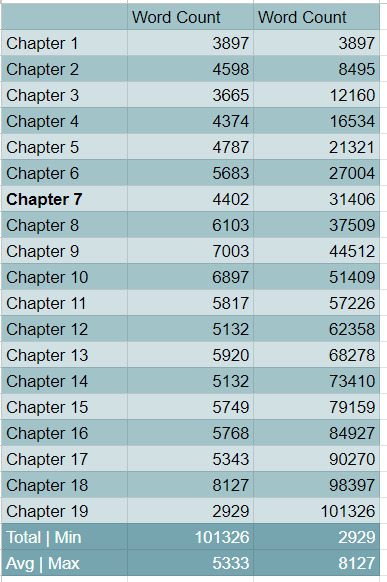
*3/30 Edit to update this chart to its full glory. Column 3 is a cumulative count. Most of what I write breaks 100k and it's fun watching the word count rise until it boils over.
This is the most frustrating to update manually, especially if you don’t have separate docs for each chapter, but it really helps me stay consistent with chapter lengths and the formula for calculating the average and rising totals is super basic.
Not that all your chapters have to be uniform, but if you care about that, this little chart is a fantastic visualizer.
If you have multiple narrators, and this book does, you can also keep track of how many POVs each narrator has, and how spread out they are. I didn’t do that for this book since it’s not an ensemble team and matters less, but I did for my sci-fi WIP, pictured below.

As I was writing that one, I had “scripted” the chapters before going back and writing out all the glorious narrative, and updated the symbols from “scripted” to “finished” accordingly.
I also have a pie chart that I had to make manually on a convoluted iPhone app to color coordinate specifically the way I wanted to easily tell who narrates the most out of the cast, and who needs more representation.
—
Google Docs
Can’t show you much here unfortunately but I’d like to take an aside to talk about my “scene bits” docs.
It’s what it says on the tin, an entire doc all labeled with different heading styles with blurbs for each scene I want to include at some point in the book so I can hop around easily. Whether they make it into the manuscript or not, all practice is good practice and I like to keep old ideas because they might be useful in unsuspecting ways later.
Separate from that, I keep most of my deleted scenes and scene chunks for, again, possible use later in a “deleted scenes” doc, all labeled accordingly.
When I designed my alien language for the sci-fi series, I created a Word doc dictionary and my own "translation" matrix, for easy look-up or word generation whenever I needed it (do y'all want a breakdown for creating foreign languages? It's so fun).
Normally, as with my sci-fi series, I have an entire doc filled with character sheets and important details, I just… didn’t do that for this book. But the point is—you can still make those for free on any word processing software, you don’t need fancy gadgets.
—
I hope this helps anyone struggling! It doesn’t have to be fancy. It doesn’t have to be expensive. Everything I made here, minus the aforementioned timeline and pie chart, was done with basic excel skills and the paint bucket tool. I imagine this can be applicable to games, comics, what have you, it knows no bounds!
Now you have one less excuse to sit down and start writing.
#writing advice#writing resources#writing tips#writing tools#writing a book#writing#writeblr#organizing your book#outlining#shut up and write the book#google sheets#google docs
822 notes
·
View notes
Text
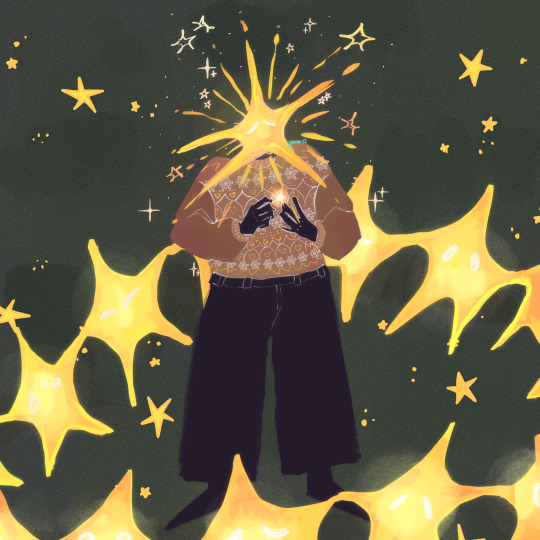
☆´。*゚+✧new chances☆´。*゚+✧
[ko-fi] [prints&stickers] [redbubble]
#sjonnies art#happy new year#digital art#artists on tumblr#2024#happy 2024#aesthetic art#my art#original art#last drawing of 2023 and first drawing of 2024 hehe here's to an abundance of creativity yet to come!!!#to new chances and new ideas and new doors to open!!!! new friends and new love!!!!#news year resolution: draw!!!! and paint!!!! and create!!!!#i want to publish at least 2 fics as well and get started on the comic that's rotating in my head#and maybe outline the children's book im thinking about#but there's 364 days for that <3
344 notes
·
View notes
Text
Stripping away Supports
In classic outlining structure, the midpoint is where your MC loses all the advantages they’d relied on up until that point—allies, resources, powers, etc. In fact, this structure is used in so many films that the ‘characters fight at the midpoint’ is an easily found cliché throughout media.
However, there are other ways of stripping away your MC’s supports to achieve the same effect.
They fight
Okay I know I just implied we might want to avoid this, but why fix what’s not broke? The important part about following the ‘characters fight at the midpoint’ trope is to ensure the fight doesn’t start at the midpoint, but rather starts from the very moment the characters are seen with each other/meet. The fight should be about something that’s been brewing underneath all of their interactions from the beginning—the one thing they should’ve talked about but didn’t. The ‘elephant in the room’.
This fight is less of a fight but an unearthing of feelings, thoughts, and problems that have always been there, but have been ignored or avoided up until then. What’s the event that unearths these truths? Typically, something threatening or scary causes people to speak ‘out of turn’…
2. The protagonist chooses to go on alone
Something big happened, something so dangerous and scary that the protagonist intentionally pushes away their allies in order to protect them… Of course, later they might realize that they are stronger together anyway. This is also a bit of a cliché, but done thoughtfully can be very impactful.
3. The allies are in over their head
The reversal of the last trope, instead of the protagonist pushing their allies away, the allies decide this quest is far too dangerous and risky for them… The protagonist is abandoned by their allies. Later, these supports may return, their love for the protagonist stronger than their fear of the situation, but whatever happened must have spooked them bad enough to lead them to betrayal.
4. An integral piece they’ve been relying on has been destroyed
The hideout was found and torched, the old man’s journal was tossed into the sea, the leader/mentor/keeper of information has been kidnapped or killed. Maybe the allies and the protagonist are still together, but one important thing that’s been keeping them together or leading them has been lost, now they have to adapt and improvise on the fly if they wish to continue their quest.
5. An integral piece they’ve been relying on turned out to not be true or important
Similar to the last but with a bit of a twist. They’ve been following the wrong lead all along—where to go next now that the very foundation of their quest is crumbling beneath them?
What are some other ways of fulfilling the midpoint reversal?
#writing#writers#writing tips#writing advice#writing inspiration#creative writing#writing community#books#film#filmmaking#screenwriting#novel writing#fanfiction#writeblr#midpoint#midpoint reversal#stripping away supports#outlining#planning
580 notes
·
View notes
Quote
Writing comes out of tension, tension between what's inside and what's outside.
Rachel Cusk, Outline
168 notes
·
View notes
Text

Falling back in love with your craft
#svsss#shang qinghua#scum villain#you know i think about how Shang Qinghua had an idea for PIDW and had to forgo it to cater to his fanbase#and how he met a reader that even if he shat on it loved his book and even helped to bring his real outline to life#i like to think he got back into writing in his new life and gets to make the stuff he wants#he's not pressured to do anything but create and just#fall in love with the process again#im projecting#✌️ but seriously it makes me insane to think about how even if shang Qinghua made that whole novel his number one hater still read it all#STILL loved part of the book so much#like it just makes me think theres always someone out there thatll see a peice of you in all your work and latch onto it to love#my art#nibbelraz
365 notes
·
View notes
Text
The Character Backstory Workbook is here!
This is for writers who love character profile templates but hate that they don't give you enough room to write and you want to do psychological deep dives on your characters. Also, I'm using Rosie from my novella Truth Weekend in this video as an example.
Click here for the workbook.
Click here to watch the full YouTube video!
#writblr#screenwriting#writing#writers block#writers on tumblr#writers and poets#writerscommunity#creative writing#writerslife#writing resources#writing reference#writing romance#ocs#original character#character profile#book outline#writing template#writing techniques#writing inspiration#novel writing#on writing#writing prompt#writing process#literature#words
2 notes
·
View notes
Text

This Is What Makes Us Girls ~ Lana Del Rey
#This Is What Makes Us Girls#lana del rey#lana lyrics#gif warning#glitter text#lyrics#pink#no outline#bloggif.com#33px#lana how i hate those guys#bambi eyes#high femme lesbian song#book antiqua bold italic#book antiqua font#click for better quality#album: born to die
213 notes
·
View notes
Text
FINAL CHAPTER FINAL CHAPTER FINAL CHAPTER--
This is for the second Fox's Tongue book. It is always such a high, sitting down and staring at the very last of my outline notes. Like, that's it, folks. Hoping to actually finish writing this weekend. Then I can treat myself to some Blind!Zuko outlining, or maybe finish up Little Zuko. As a treat. <3
#a treat#and also because I need to check over the third book's outline#which is always best done in the same manner as befriending a feral cat: sit down near it and ignore it until it comes to headbutt you#blind!Zuko outline has been headbutting me all week and BOY do I feel sorry for Iroh#you keep the White Lotus from Zuko? you try to give blind nephew peace and security? oh hijinks for Iroh! hijinks for a thousand pages!#please not actually for a thousand pages#please#fox's tongue and kirin's bone
163 notes
·
View notes